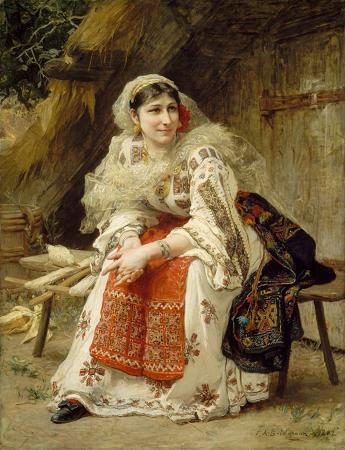
Frederick Arthur Bridgman. Frederick Arthur Bridgman was an American artist known for his paintings of Orientalist subjects.
Born in Tuskegee, Alabama, Bridgman was the son of a physician. He began as a draughtsman in New York City, for the American Bank Note Company in 1864-65, and studied art in the same years at the Brooklyn Art Association and at the National Academy of Design.
He went to Paris in 1866, and in 1867 he entered the studio of the noted academic painter Jean-Léon Gérôme, where he was deeply influenced by Gérôme's precise draftsmanship, smooth finishes, and concern for Middle-Eastern themes. Thereafter, Paris became his headquarters.
In 1874, he was elected into the National Academy of Design as an Associate member, and became a full member in 1881. Bridgman made his first trip to North Africa between 1872 and 1874, dividing his time between Algeria and Egypt.
There he executed approximately three hundred sketches, which became the source material for several later oil paintings that attracted immediate attention. Bridgman became known as the American Gérôme, although Bridgman would later adopt a more naturalistic aesthetic, emphasizing bright colors and painterly brushwork. His large and important composition, The funeral rites of a mummy on the Nile, exhibited at the Paris Salon in 1877 and Royal Academy of Arts in 1881, bought by James Gordon Bennett, Jr., brought him the Cross of the
Born in Tuskegee, Alabama, Bridgman was the son of a physician. He began as a draughtsman in New York City, for the American Bank Note Company in 1864-65, and studied art in the same years at the Brooklyn Art Association and at the National Academy of Design.
He went to Paris in 1866, and in 1867 he entered the studio of the noted academic painter Jean-Léon Gérôme, where he was deeply influenced by Gérôme's precise draftsmanship, smooth finishes, and concern for Middle-Eastern themes. Thereafter, Paris became his headquarters.
In 1874, he was elected into the National Academy of Design as an Associate member, and became a full member in 1881. Bridgman made his first trip to North Africa between 1872 and 1874, dividing his time between Algeria and Egypt.
There he executed approximately three hundred sketches, which became the source material for several later oil paintings that attracted immediate attention. Bridgman became known as the American Gérôme, although Bridgman would later adopt a more naturalistic aesthetic, emphasizing bright colors and painterly brushwork. His large and important composition, The funeral rites of a mummy on the Nile, exhibited at the Paris Salon in 1877 and Royal Academy of Arts in 1881, bought by James Gordon Bennett, Jr., brought him the Cross of the
Wikipedia ...